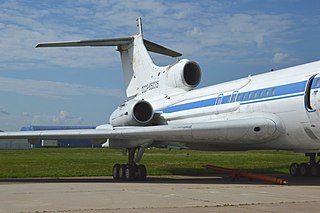Related Research Articles

The Ilyushin Il-18 is a large turboprop airliner that first flew in 1957 and became one of the best known and most durable Soviet aircraft of its era. The Il-18 was one of the world's principal airliners for several decades and was widely exported. Due to the aircraft's airframe durability, many examples achieved over 45,000 flight hours and the type remains operational in both military and civilian capacities. The Il-18's successor was the long range Il-62 jet airliner.

The Tupolev Tu-85 was a Soviet prototype strategic bomber based on the Tu-4, an unlicensed, reverse engineered copy of the Boeing B-29 Superfortress. It was the ultimate development of the B-29 family, being over 50% heavier than its progenitor and had nearly double the range. Only two prototypes were built before the program was cancelled in favor of the turboprop powered Tupolev Tu-95 bomber which could cover the same range at a far higher speed.

The Antonov An-10 Ukraina is a four-engined turboprop passenger transport aircraft designed in the Soviet Union.
The Kuznetsov Design Bureau was a Russian design bureau for aircraft engines, administrated in Soviet times by Nikolai Dmitriyevich Kuznetsov. It was also known as (G)NPO Trud and Kuybyshev Engine Design Bureau (KKBM).

The Kuznetsov NK-12 is a Soviet turboprop engine of the 1950s, designed by the Kuznetsov design bureau. The NK-12 drives two large four-bladed contra-rotating propellers, 5.6 m (18 ft) diameter (NK-12MA), and 6.2 m (20 ft) diameter (NK-12MV). It is the most powerful turboprop engine to enter service.

The Tupolev Tu-95LAL was an experimental aircraft that was a modified Tupolev Tu-95 Soviet bomber aircraft, which flew from 1961 to 1965, analogous to the United States' earlier Convair NB-36H. It was intended to see whether a nuclear reactor could be used to power an aircraft, primarily testing airborne operation of a reactor and shielding for components and crew. The reactor did not actually power the aircraft.

The A-90 Orlyonok is a Soviet ekranoplan that was designed by Rostislav Evgenievich Alexeyev of the Central Hydrofoil Design Bureau.

The Kuznetsov NK-86 is a low bypass turbofan engine used on the Ilyushin Il-86 rated at 13,000 kgf or 28,600 lbf thrust. It is made by the Soviet Kuznetsov Design Bureau. It is an upgraded version of the Kuznetsov NK-8.
The Kuznetsov NK-87 is a low-bypass turbofan engine rated at 127.5 kN thrust. It powers the Lun-class ekranoplan. It is made by the soviet Kuznetsov Design Bureau.

The Kuznetsov NK-25 is a turbofan aircraft engine used in the Tupolev Tu-22M strategic bomber. It can equal the NK-321 engine as one of the most powerful supersonic engines in service today. It is rated at 245 kN (55,000 lbf) thrust. The three shaft engine we call the NK-25 was designed in the years 1972–1974. It is made by the Soviet Kuznetsov Design Bureau.

The Ilyushin Il-16 was a Soviet lightweight armored ground-attack aircraft developed at the end of World War II by the Ilyushin Design Bureau. It was in essence a scaled-down version of the Ilyushin Il-10, but was fitted with a newly developed Mikulin AM-43 engine with the expectation that it would be faster and more maneuverable than its predecessor. However, the engine's defects proved to be impossible to rectify and further development were canceled in mid-1946.

The Ivchenko AI-20 is a Soviet turboprop engine developed by the Ivchenko design bureau in the 1950s. It has been built in large numbers, serving as the powerplant for both the Antonov An-12 transport and the Ilyushin Il-18 airliner.
The Ilyushin DB-4 or TsKB-56 was a Soviet twin-engined bomber aircraft of the early 1940s. It was a development of the Ilyushin DB-3 and was intended as a replacement for the earlier aircraft, but only two prototypes were built; engine problems and the need to concentrate production on existing types following the German invasion of the Soviet Union in June 1941 meant that no more examples were built.

The Progress D-236 was an experimental aircraft engine, a hybrid between a turbofan and a turboprop known as a propfan. Also known as the Lotarev D-236T, the three-shaft geared engine was designed in the 1980s and 1990s to power proposed propfan aircraft such as the Tupolev Tu-334, Ilyushin Il-118, and Ilyushin Il-88.
The Kuznetsov NK-22 is an afterburning turbofan engine, designed by the Kuznetsov Design Bureau.

The Kuznetsov NK-88 was an experimental alternative fuel turbofan engine, designed by the Kuznetsov Design Bureau.
The Kuznetsov NK-89 was an experimental alternative fuel turbofan engine, designed by the Kuznetsov Design Bureau.
The Kuznetsov NK-6 was a low-bypass afterburning turbofan engine, designed by the Kuznetsov Design Bureau.

The Kuznetsov TV-022 was the first Soviet turboprop engine, designed by the Kuybyshev Engine Design Bureau.
The Kuznetsov TV-2 was a turboprop engine, designed by the Kuybyshev Engine Design Bureau.
References
- 1 2 3 4 5 6 7 8 9 10 11 12 13 14 15 16 17 Otechestvennaya aviatsionno-kosmicheskaya tekhnika - SAMARSKIY NTK (in Russian). Samara, Russia: SNTK imeni N.D.Kuznetsova. pp. 21, 72.
- ↑ Gordon, Yefim; Dmitry Komissarov (2004). OKB Ilyushin. Sergey Komissarov (1st ed.). Hinkley: Midland publishing. pp. 193–251. ISBN 1-85780-187-3.
| | This aircraft engine article is missing some (or all) of its specifications. If you have a source, you can help Wikipedia by adding them. |